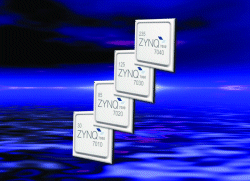
Some interesting FPGA/processor combinations have been announced recently. Intel announced Atom processors that include an Altera FPGA and meanwhile Xilinx announced FPGAs with a hard ARM Cortex-A9 processor. We gave a Product of the Year award to Microsemi for its SmartFusion family that puts an FPGA fabric, a Cortex-M3 processor, and programmable analog blocks on one chip, and Altera has its soft Nios II processor and upcoming ARM cores.
Intel announced its Atom E625C, E645C, and E665C 32-bit embedded processors with a E600 CPU core coupled with an Altera FPGA chip. The user-programmable FPGA provides 3-Gbit/s transceivers, LVDS with SerDes, memory interface, DSP blocks, and more than 60,000 logic elements. The device is a two-chip package and needs only 2.7 to 3.6 W — a perfect pair for some embedded designs, and it features extended lifecycle support. But at $61 to $106 each per 1,000, it is a bit pricey.
The Xilinx Zynq-7000 family of FPGAs tightly integrates a complete ARM Cortex-A9 processor with low-power programmable logic on one 28-nm die. The FPGAs come with 30,000 to 235,000 logic cells, dual Cortex-A9 cores, and two each of GbE, SD/SDIO, UART, CAN, USB OTG, I2 C, and SPI ports.

A high-bandwidth AMBA4 (AXI4) interconnect between the processor and the FPGA enables multi-gigabit data transfers and the chips have up to 912 GMACS of DSP processing. The two larger devices have PCIe ports and four or twelve 10.3-Gbit/s transceiver channels. All four devices include a dual 12-bit 1-Msample/s A/D converter block. They also have AES and SHA 256b for security. I’m told they will cost as little as $15 each in “high volumes” — but you can’t get a sample until sometime in the first half of next year. Xilinx also offers the MicroBlaze soft-core processor.
Two more contenders
Altera has the Nios II soft-core processor that gives embedded designers the flexibility to choose the exact set of CPUs, peripherals, and memory needed. The Nios also provides the all-important ability be updated and thus reduce the risk of processor obsolescence. The Cortex-M1 soft-core is also available. Altera is also bringing a hard-coded MIPS Technologies MIPS32 processor to its FPGAs. They tell me they will deliver products with hardened Cortex-A9 processor-based subsystems done in 28-nm — with more detailed information available in a few months.
Last, but certainly not least, are Microsemi’s SmartFusion products that combine a 60 to 500-K-logic-element FPGA, a 100-MHz ARM Cortex-M3, and programmable analog blocks on one chip. The hard-coded CPU has up to 512 Kbytes of flash and 64 Kbytes of SRAM and a multilayer AHB communications bus matrix to talk to everything. The chip’s analog subsystem has 12-bit A/D and D/A converters, signal-conditioning blocks, voltage and current monitors, and a temperature monitor.

It also has a 10/100 Ethernet MAC, SPI, I2 C, and UART interfaces. SmartFusion versions range from less than $10 to $50 and come in temperature grades up to –40° to 100°C.
Jim Harrison
Advertisement
Learn more about Electronic Products Magazine





